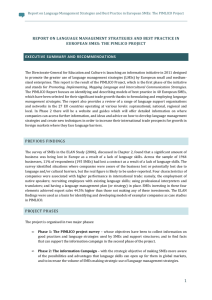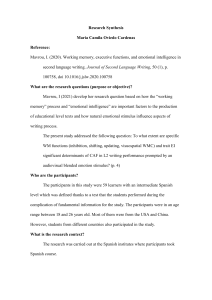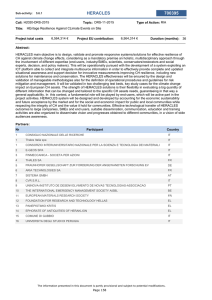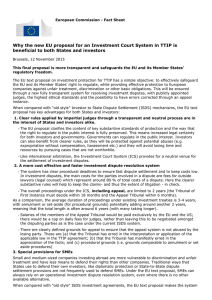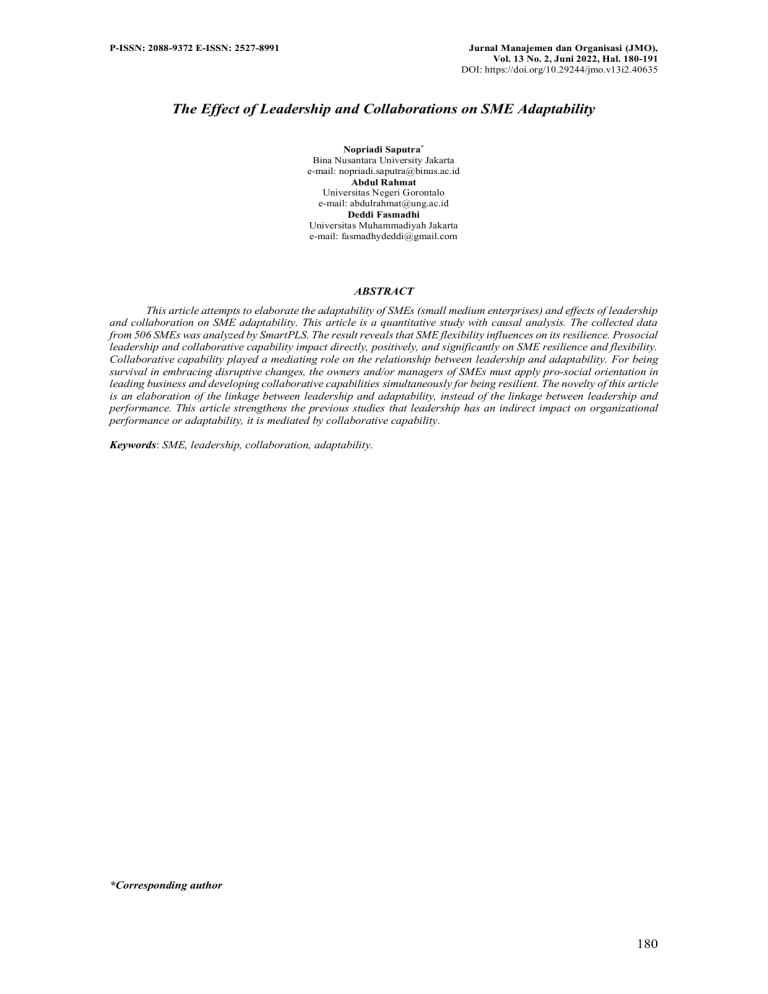
P-ISSN: 2088-9372 E-ISSN: 2527-8991 Jurnal Manajemen dan Organisasi (JMO), Vol. 13 No. 2, Juni 2022, Hal. 180-191 DOI: https://doi.org/10.29244/jmo.v13i2.40635 The Effect of Leadership and Collaborations on SME Adaptability Nopriadi Saputra* Bina Nusantara University Jakarta e-mail: nopriadi.saputra@binus.ac.id Abdul Rahmat Universitas Negeri Gorontalo e-mail: abdulrahmat@ung.ac.id Deddi Fasmadhi Universitas Muhammadiyah Jakarta e-mail: fasmadhydeddi@gmail.com ABSTRACT This article attempts to elaborate the adaptability of SMEs (small medium enterprises) and effects of leadership and collaboration on SME adaptability. This article is a quantitative study with causal analysis. The collected data from 506 SMEs was analyzed by SmartPLS. The result reveals that SME flexibility influences on its resilience. Prosocial leadership and collaborative capability impact directly, positively, and significantly on SME resilience and flexibility. Collaborative capability played a mediating role on the relationship between leadership and adaptability. For being survival in embracing disruptive changes, the owners and/or managers of SMEs must apply pro-social orientation in leading business and developing collaborative capabilities simultaneously for being resilient. The novelty of this article is an elaboration of the linkage between leadership and adaptability, instead of the linkage between leadership and performance. This article strengthens the previous studies that leadership has an indirect impact on organizational performance or adaptability, it is mediated by collaborative capability. Keywords: SME, leadership, collaboration, adaptability. *Corresponding author 180 INTRODUCTION The world globally has suffered several economic crises that put heavy pressure on SMEs or small and medium enterprises, such as the Great Depression in 1930s, the financial crisis in late 2000s and, most recently, the global crisis. COVID-19. This crisis is draining a lot of resources and markets needed by SMEs to grow (Tsilika, Kakouris, Apostolopoulos, & Dermatis, 2020). COVID-19 has caused governments from many countries to implement social distancing to stop the transmission of the disease. The policy affect the households of entrepreneurs and SMEs then results in business failure and the consequences of job loss (Castro & Zermeño, 2020). SMEs generally do not have the liquidity that allows them to meet their salary and working capital needs (OECD, 2020) initiated an unpredictable crisis for SMEs (Păunescu & Mátyus, 2020 and causing deadly collapse (Beninger & Francis, 2021). Baldwin and Weder in Mauro (2020) has predicted that COVID-19 outbreak were having a huge economical effect spill over globally in three main channels through: (1) supply, many substantial disturbances in the global supply chain, plant closures, and declines in numerous activities of service sector; (2) demand, a significant reduced in business travel and tourism, drops in education services, and sharply decreases in leisure and entertainment services; (3) confidence, which uncertainty or ambiguity leading to delayed consumption of goods and services, reduced or foregone investment A study which was supported by more than 5,800 SMEs in USA found that COVID-19 has affected on business with vast layoffs, risk of closures, financially volatile, and looking for funding through CARAS Act (Bartik, Bertrand, Cullen, Glaeser, Luca, & Stanton, 2020). In China The outbreak and the resultant lockdowns of COVID-19 took a serious charge on SMEs, such as demand drop, logistics blocks, and troubled labors in 80 percent of SMEs. Around 19 percent – 25 percent of SMEs, particularly export firms had permanently shut down (Dai et al., 2021). In developed countries - such as European Union countries, SMEs contribute about 54 percent on gross output of private sector; dominate job market about 99,8 percent of all employer, and provides about 65 percent, on employment in private sector (Gourinchas, Kalemli-Özcan, Penciakova, & Sander, 2020). In developing country like Indonesia, SMEs are about 63 million units which produce gross domestic product about 60 percent (Surya, Menne, Sabhan, Suriani, Abubakar, & Idris, 2021). Those facts prove that SMEs plays an strategic part in the national and global economy. if something happens to SMEs, it will have a broad impact on the national and global economy. As a suddenly disruptive event, COVID-19 pushes SMEs to become adaptable in disruptive time (Aldianto, Anggadwita, Permatasari, Mirzanti, & Williamson, 2021). COVID-19 brings a distinctive examination for the adaptability of SME (Bryce, Ring, Ashby, & Wardman, 2020). Monsoon (2017) distinguishes the SMEs' adaptability in two ways: (1) vulnerability as ability to resist to external shocks and (2) adaptability as ability to recover from such shocks. This article represents SMEs' adaptability into two conceptual approaches: business resilience and business flexibility. Business resilience is correlated to the capability to adapt to new circumstances and to become sustainable for the long-term (Korber & McNaughton, 2017). Business flexibility is SME capability to develop of new different businesses, products, and/or market by utilizing current resources and reconfiguring existing business processes (Libert, Beck, & Wind, 2016) Based on a literature reviews systematically, Castro and Zermeño (2020) has found that adaptability of SME can be improved by developing entrepreneurs as managers and/or owners of SME in five domains: (1) suitability of business-entrepreneur characteristics, (2) mental attitudes toward the crisis, (3) institutional relationships,( 4) social and human capital, and (5) strategic management. This study is an attempt to elaborate and examine impact leadership - as social and human capital aspect and collaboration as institutional relationship on SMEs' adaptability. Jurnal Manajemen dan Organisasi (JMO), Vol. 13 No. 2, Juni 2022, 180-191 181 Literature Reviews Business Resilience According to Sabatino (2016) resilience is a Latin word “resiliere” that means means recuperate or bounce back or recover or get better. Holling (1973) explained the term came from the science of ecology which is explained as the ability of a system to reverting to stability after a distress (Holling, 1973). Now, term of esilience has been applied in a variety of domains, such as sociology, disaster management, engineering, business administration, and psychology (Korber & McNaughton, 2017). Aldianto et al. (2021), stated that a resilient organization will always be able to look for the ways to take advantages on many situations. Business resilience is described as the organizational capability to remain unaffected and to adapt dynamic changes affected by external factors. (Kurtz & Varvakis, 2016). Other scholar defined business resilience as a collective capability to keep its resources at a stable level by being self-supported and getting rationalized if a disruptive event happens (Păunescu & Mátyus, 2020). Kantur and Say (2015) develop organizational resilience scale for capturing business resilience which reflected the construct into three main dimensions: (1) robustness, (2) agility, and (3) integrity. Business Flexibility In today’s volatile circumstances, keeping a competitive position with only one available option has become a difficult and risky for the sustainability of business. As a theoretical construct, Jain, Kashiramka, and Jain, (2020) described business flexibility as a essential capability for utilizing a variety of possible mechanisms in freedom of choice on various processes. It is quite similar with Volberda (1996) who explained business flexibility as the degree to which an SME has a variety of alternatives on managerial capabilities and the speed at which they can be utilized for improving business controllability. Miroshnychenko, Strobl, Matzler, and De Massis (2020) stated that business flexibility emphasizes on the flexible resources utilization, to reconfigure the processes autonomously and affects explorative innovation and business development positively. Relating to SMEs’ circumstances during the crisis, business flexibility is capability to detect a variety new possible businesses, products, and/or market by reconfiguring business process and utilizing existing resources. Operationalization of business flexibility is based on PIVOT concept (Libert, Beck, & Wind, 2016) which is reflected into 14 indicators from five dimensions. Previous studies has proven that flexibility and resilience influence each other reciprocally. A study found that business flexibility plays as mediator in relationship between data analysis capability and supply chain resilience (Dubey, Gunasekaran, Childe, Fosso Wamba, Roubaud & Foropon, 2021). It means that flexibility is an influential factor of resilience. But another empirical study revealed that flexibility of supply chain plays a mediating role on relationship between resilience of supply chain and firm performance (Chunsheng, Wong, Yang, Shang, & Lirn, 2019). It means that resilience is an antecedent for flexibility. This article chooses to examine the effects of business flexibility on business resilience. Does business flexibility influence on business resilience positively and significantly? Hypothesis 1: Business flexibility impacts on business resilience. Collaboration Capability Gomes-Casseres (1997) argued that when a company is smaller to their competitors and to their market relatively, the company tends to collaborate with others to gain economies of scale. SMEs' ability to collaborate may be associated with collaborative capability or relational competence or relational capability (Kohtamäki, Rabetino, & Möller, 2018). Collaboration capability refers to organizational ability to find out, share, and keep knowledge regarding managing collaboration and to exploit the knowledge of collaborations in current and future perspective (Niesten & Jolink, 2015). This study defined collaboration capability into eight indicators for three dimensions (e.g., learning, integration, and management) and (Kohtamäki, Rabetino, & Möller, 2018). Previous studies found that supply chain resilience was influenced by collaborative activities (Scholten & Schilder, 2015; Medel, Kousar, & Masood, 2020; Dubey, et al., 2021). Another empirical study in Taiwan which invite 309 logistics managers to participate found that 182 Jurnal Manajemen dan Organisasi (JMO), Vol. 13 No. 2, Juni 2022, 180-191 collaboration between logistic service providers and their customers impacts on flexibility capability (Chou, Chen, & Kuo, 2018). These facts indicate that collaboration influences both resilience and flexibility. Based on those facts, this article postulates two hypothesizes that collaboration capability simultaneously impacts on business resilience and business flexibility. Hypothesis 2: Collaboration capability impacts on business resilience. Hypothesis 3: Collaboration capability impacts on business flexibility. Pro-Social Leadership During the COVID-19 pandemic, many entrepreneurs who continue to run their businesses must suffer losses, just because they want to help employees continue to earn income to support their families. This behavior of SMEs' owner reflects a pro-social behavior. Pro-social behavior from the entrepreneurs as owner and/or manager of SMEs is referred to as pro-social leadership. Pro-social leadership is a concept of leadership which appears frequently. Although during difficult time, most people tend to be concerned more on their own security rather than other's security. But during COVID-19 pandemic in Indonesia many managers and/or owners of SME present the pro-social behavior in doing their business. Lorenzi (2004) explained that pro-social leadership is a positive and effective influence of a leader to fulfil the needs of a wider social group rather than to individual or personal interests. Pro-social leadership is personal willingness of the leader - without regard to avoiding punishment or to chasing rewards, to empathise and to do something for the welfare of his/her followers or society that he/she is committed to serve (Ewest, 2017). Previous studies have proved that leadership impact on adaptability (e.g. resilience and flexibility) and collaboration. The empirical studies (Dimas, Rebelo, Lourenço, & Pessoa, 2018; Zhu, Zhang, & Shen, 2019; Franken, Plimmer, & Malinen, 2020) have proved that leadership (either in humble, transformational, or paradoxical) influences strongly on resilience (either in employee or team). This article supposes to examine the effect of prosocial leadership on business resilience. Hypothesis 4: Pro-social leadership impacts on business resilience. Obaid and Al-Abachee (2020) revealed inclusive leadership influenced strategic flexibility. Mesu, Van Riemsdijk, and Sanders (2013) revealed that transformational or transactional leadership positively associated on temporal flexibility of SMEs' labor. These empirical facts indicates that leadership o impact strongly on flexibility. This article tries to test the influence of pro-social leadership on business flexibility. Hypothesis 5: Pro-social leadership impacts on business flexibility. Çoban and Atasoy (2020) have proved that distributed leadership impacted organizational innovativeness via teacher collaboration. Distributed leadership of school principal impacted on teacher collaboration then impacted on organizational innovativeness. A previous study in Malaysia with involved 500 officers in various ministries found that transformational leadership has influenced collaboration outcomes, interdependence, and relational capital (Ramadass, Sambasivan, & Xavier, 2018). Those two previous studies have indicated that leadership has strong impact on collaboration. This article postulates that pro-social leadership influences on collaboration capability. Hypothesis 6: Pro-social leadership impacts on collaboration capability. RESEARCH METHOD Jurnal Manajemen dan Organisasi (JMO), Vol. 13 No. 2, Juni 2022, 180-191 Based on previous explanation on hypothesizes development, this article has four variables such as business resilience (BUSRES) and business flexibility (BUSFLX) as representation of SME adaptability during COVID-19, pro-social leadership (PROSOC), and collaboration capability (COLACAP). BUSRES plays as dependent variable. BUSFLX as intervening variable. PROSOC and COLACAP play as independent variables. The four variables are structured as first order construct in the proposed research model which is display at Figure 1. This article adopted instruments from the previous studies for measuring all of variables. For measuring BUSRES, this article used organizational resilience scale (Kantur, & Say, 2015) 183 which reflected in three dimensions (e.g., robustness, agility, and integrity) and into nine items. BUSFLX was conceptualized by using PIVOT concept (Libert, Beck, & Wind, 2016) which reflected in five dimensions and 14 items. PROSOC was measured by eight items. Meanwhile, COLACAP was measured by nine items which comes from alliance capability concept (Kohtamäki, Rabetino, & Möller, 2018). Figure 1: Proposed research model Currently, there are more than 65 million SMEs spread across Indonesia. In 2016, there were 61,7 million SMEs in Indonesia. The number continues to increase, in 2017, the number of SMEs reached 62,9 million and in 2018, the number of SMEs reached 64,2 million. It is predicted that in 2019, 2020 to 2021 the number will continue to increase (Christy, 2021). It is predicted that about 65 percent to 75 percent of Indonesian SMEs are located in Jawa or Sumatera. According to Krejcie and Morgan (1970), it explained that for very large population (more than 1.000.000 population) it could be approached by 384 respondents as sample size. By using the online questionnaires, the data was collected from social media of entrepreneurship or SME associations in several provinces in Sumatera (such as Aceh, Sumatra Utara, Sumatra Barat, Sumatera Selatan, and Lampung) and Jawa island (such as DKI Jaya, Banten, Jawa Barat, Jawa Tengah, and Jawa Timur). This collecting data approach tends to be convenience which is as non-probabilistic sampling method. It involved about 506 owners and/or managers of SMEs as the respondents. It is sufficient for making conclusion about SME in Indonesia. The collected data was structured into first order constructs for all variables by utilized Partial Least Square based SEM. SmartPLS is used for calculating in two steps - PLS Algorithm and bootstrapping calculation. Validity and reliability analysis was conducted based on PLS Algorithm calculation. Meanwhile, hypothesizes testing were conducted based on bootstrapping calculation. RESULTS AND DISCUSSION Table 1 shows profile of the respondents. The sample has more women than men as the respondents. Half of the respondents (53 percent) have age below than 40 years old. It indicates that half of respondents are millennials. Most of respondents (79 percent) has higher education background with diploma's, bachelor's, master's, and doctoral degree. Most of them (64 percent) are manager and manager/owner of SME. It means that respondents have direct control and access on the daily business operation of SME. Most of them have dual perspectives of business - both strategic and tactical perspectives. Most of respondents are running SMEs in small business scale which has assets less than Rp 50 million or revenue per years less than Rp 300 million. 184 Jurnal Manajemen dan Organisasi (JMO), Vol. 13 No. 2, Juni 2022, 180-191 Table 1. Profile of Respondents Gender Age Education Position Business Scale Profiles of Respondents Man Women 20 - 29 30 - 39 40 - 49 50 - 59 > 59 Basic Education Diploma Bachelor Master Doctor Owner Owner or Manager Manager Micro Small Medium 223 283 101 167 147 71 20 106 86 202 86 25 182 238 86 349 106 51 44% 56% 20% 33% 29% 14% 4% 21% 17% 40% 17% 5% 36% 47% 17% 69% 21% 10% 44% 100% 20% 53% 82% 96% 100% 21% 38% 78% 95% 100% 36% 83% 100% 69% 90% 100% From PLS algorithm calculation, validity and reliability analysis was conducted. Validity analysis on items or indicators used Outer Loading (OL) scores. Items with OL score more than 0,60 is indicated as a valid item. Table 2 demonstrates all valid items. There are five valid items for BUSRES, eight valid items for BUSFLX, eight valid items for PROSOC, and nine valid items for COLACAP. All items of COLACAP dan PROSOC are valid. Meanwhile, four items of BUSRES and six items of BUSFLX are excluded from research model because OL score less than 0,60. For validating the variables, average variance extracted (AVE) score indicates the validity. A variable with AVE score more than 0,50 is defined as valid one. BUSRES (0,59), BUSFLX (0,51), PROSOC (0.59) and COLACAP (0,63) have AVE score more than 0.50. All variables are valid. Table 3 strengthen the validity of variable demonstrates discriminant validity result. All variables are discriminant valid too, because all square root of AVE (diagonally bold scores) are more than 0,70 or as the highest score in each column. For reliability analysis, Table 2 shows Cronbach's Alpha (CA) and Composite Reliability (CR) scores. A variable is reliable if CA or CR score more than 0,70. All variables - BUSRES, BUSFLX, PROSOC, and COLACAP have CA and CR scores more than 0,70. Based on validity and reliability analysis all items and variable in Table 2 and Table 3 are valid and reliable. Table 2. Validity and Reliability Analysis Variable Item BR05 BR09 Business Resilience (BUSRES) BR06 BR07 BR08 Jurnal Manajemen dan Organisasi (JMO), Vol. 13 No. 2, Juni 2022, 180-191 185 Description During COVID-19, I act more rapidly During COVI-19, I am successful in acting with all its employees During Covid-19 I develops alternatives to benefit from negative circumstances Our teams are responsive in taking required action when it demanded Our organization is a home where all the employees engaged to do what is required from them OL AVE CR CA 0,59 0,82 0,87 0,64 0,74 0,75 0,83 0,84 Variable Item BF09 BF14 BF04 BF06 Business Flexibility (BUSFLX) BF07 BF08 BF12 BF11 PR05 PR06 PR04 Pro Social Leadership (PROSOC) PR03 PR01 PR02 PR08 PR07 CO01 CO04 CO08 Description I can run a different kind of business by utilizing internet completely I observe the capability of my teams to work together I have sufficient knowledge for switching to the different businesses I have a relationship that supports me for switching to different businesses For switching into different businesses, I have understood the network of suppliers and its market comprehensively For switching into different businesses, I understand the business process comprehensively I observe the development of my business networks periodically I maintain business networking for finding out the newly different businesses I provide additional cash for assisting employees to keep them going I sell or give up my personal property to help the employee's living expenses I involve employees in making business decisions I engage employees to look for ideas for creating new product or business I tell employees that the business is our ship or home for being together I tell employees that the growth or declining of our business is the product of our togetherness I share experiences or stories to strengthen employee morale AVE CR CA 0,s51 0,86 0,89 0,59 0,9 0,92 0,63 0,93 0,94 0,67 0,67 0,69 0,69 0,71 0,73 0,77 0,77 0,67 0,69 0,74 0,76 0,79 0,82 0,83 I spend time with them to encourage them to survive In business collaboration, I am involved in setting of common business goals In business collaboration, we strive for closer relationships 0,85 In business collaboration, we develop new business 0,77 I evaluate progress of our business collaboration periodically Collaborative In business collaboration, I am involved in arranging CO02 Capability distribution of tasks and responsibilities (COLACAP) In business collaboration, we exchange information CO09 about success or failure in doing business with For maintaining business collaboration, we create a CO05 separate organizational structure From business collaboration, we gain new knowledge CO06 about business From business collaboration, we exchange business CO07 experience Note: CA = Cronbach's Alpha; CR = Composite Reliability OL= Outer Loading, AVE = Average Variance Extracted CO03 OL 0,74 0,75 0,78 0,79 0,81 0,82 0,85 0,86 Jurnal Manajemen dan Organisasi (JMO), Vol. 13 No. 2, Juni 2022, 180-191 186 Table 3. Discriminant Validity Variables [1] Business Flexibility [2] Business Resilience [3] Collaborative Capability [4] Pro-Social Leadership [1] 0,714 0,503 0,274 0,496 [2] [3] 0,765 0,175 0,393 0,797 0,472 [4] 0,771 Besides validity and reliability analysis, PLS algorithm calculation also produce r-square or determinant coefficient. Table 2 displays determinant coefficient of BUSRES is 0.292. It means that variation in business resilience is influenced by variation in PROSOC, BUSFLX, and COLACAP about 29,2 percent. There are about 70,8 percent variation is determined by other factors which are not studied yet in this article. BUSFLX is determined by PROSOC and COLACAP about 26,1 percent. PROSOC contributes about 58,5 percent on COLACAP. Figure 2. Result of PLS algorithm calculation Based on bootstrapping calculation with 500 subsamples, path coefficient or beta score are found in Table 4 and Figure 3. From six hypothesizes, five one is accepted and only one is rejected. BUSRES is influenced directly and significantly by BUSFLX and COLACAP. PROSOC does not influence BUSRES directly and significantly. PROSOC influences directly and significantly on BUSFLX and COLACAP. PROSOC influences BUSRES indirectly by influencing COLACAP or BUSFLX then influences BUSRES. Besides influencing BUSRES, COLACAP also influences directly and significantly on BUSFLX. Figure 3 displays that BUSFLX plays mediating role on the relationship between PROSOC and BUSRES. Through influencing BUSFLX, PROSOC impact indirectly on BUSRES. But it does not do the same on the relationship between COLACAP and BUSRES. Because the direct impact (COLACAP BUSRES) has path coefficient (0,155) higher than the indirect path (COLACAP BUSFLX BUSRES) with combined path coefficient 0,141 (= 0,38 x 0,37). Besides BUSFLX, COLACAP also play mediating role on relationship between PROSOC and BUSFLX. Because the indirect path (PROSOCCOLACAPBUSFLX) has higher impact (0,292 = 0,765 x 0,382) than direct path (PROSOC BUSFLX, 0,156). Jurnal Manajemen dan Organisasi (JMO), Vol. 13 No. 2, Juni 2022, 180-191 187 Table 4. Hypothesizes Testing Hypothesizes H1: Business Flexibility ==> Business Resilience H2: Collaborative Capability ==> Business Resilience H3: Collaborative Capability ==> Business Flexibility H4: Pro-Social Leadership ==> Business Resilience H5: Pro-Social Leadership ==> Business Flexibility Pro-Social Leadership ==> Collaborative H6: Capability Beta 0,37 0,16 0,38 0,11 0,16 0,77 t-Statistics p-Values 8,55 0,00 2,34 0,02 6,14 0,00 1,67 0,09 2,48 0,01 33,38 0,00 Result Accepted Accepted Accepted Rejected Accepted Accepted SMEs as one of the pillars of the national economy have repeatedly faced crises. At least in the past two decades, three major crises have occurred, namely the 1998 Economic Crisis, 2010 Economic Crisis, and the 2020 COVID-19 Crisis. Changes in the business environment, which are repeated repeatedly, require the ability of SMEs to adapt. Associated with the ability to adapt, the role of leadership is central. Because throughout its life cycle, the initiatives and efforts made by the SMEs owners and or managers to determine the progress, decline, development, and extinction of SMEs as business organizations. Business resilience and business flexibility are used for representing adaptability of SMEs in the current COVID-19 pandemic. The business resilience is the ability of SMEs to survive in running business which is illustrated by robustness, agility, and integrity. Resilient SMEs are robust in dealing with difficulties during crises, agile in responding to required business changes, and able to maintain their unity as a business organization. Business flexibility is the ability of SMEs to move from their current business to completely different new businesses by leveraging digital technology, collaboration, and existing resources. A flexible SME is an SME that can quickly and effectively move to a different new business. SME with high business flexibility has a large opportunity to be resilient in running business. Because COVID-19 has caused certain businesses to die such as tourism, entertainment, and transportation businesses. But on the other hand, COVID-19 has caused other businesses to grow rapidly, such as the medicine business, delivery service, and telecommunications. SME that has good business flexibility will be able to move quickly and effectively, leaving the old business that is shrinking to a new business that is growing. Business flexibility influence strongly business resilience. Jurnal Manajemen dan Organisasi (JMO), Vol. 13 No. 2, Juni 2022, 180-191 Figure 3. Result of bootstrapping calculation. 188 The development of business flexibility requires a certain leadership approach from the owners and/or managers of SMEs. The results of previous data analysis have proven that prosocial leadership has a significant effect on business flexibility. Prosocial leadership is a leadership approach in which SME managers and/or owners pay genuine and empathetic attention to employees affected by the crisis. Owners and/or managers provide financial and psychological support to employees to be strong and survive in the face of crises. Prosocial leadership is not just a lip-service. However, employees really feel it as the owner and/or manager's concern for the employees so that employees are willing to survive and fight for the survival of SME as a business organization. In addition to prosocial leadership, business flexibility can also be developed through the development of collaboration capabilities. The ability of SME as a business organization to collaborate with various parties and organizations will facilitate SME in conducting business flexibility. The ability to collaborate also has a direct effect on business resilience. In the application of pro-social leadership, collaboration capability is a mediator. The application of prosocial leadership should be directed for developing collaboration capability of SMEs to affect more significantly on the business flexibility. CONCLUSSIONS COVID-19 requires the adaptability of SMEs as one of the pillars of the national economy. This adaptability can be reflected in the capability to be resilient and flexible. The flexibility of UKMK will determine the resilience of UKM. Leadership also has a strong influence on the adaptability. Prosocial leadership plays a role in developing business flexibility and collaboration capabilities. Flexibility and collaboration are key words in building SME adaptive to the COVID19 crisis. This study has several limitations in providing the resulting conclusions. The first is related to the sampling method. For providing more accurate conclusions about SMEs in Indonesia, it is better to use a probabilistic method with a stratified cluster random sampling approach. The sample was carried out randomly in the Sumatra and Java clusters separately. Then, respondents were stratified based on business scale. The study needs to collaborate with government institution that manage SMEs such as the Ministry of Cooperatives and SMEs for getting more random samples. Second, relates to the instruments used for measure business resilience (BUSRES) and business flexibility (BUSFLX). Because not all items on both variables are valid, then for further study, new instruments that are more valid and relevant should be used or developed. The third relates to other variables that affect business resilience. Statistical results show that business resilience is influenced by around 70 percent by other factors not discussed in this article. Future research is recommended to examine factors such as digital readiness, learning agility, innovation capability, and other types of leadership concept - such as ambidextrous or entrepreneurial leadership. REFERENCES Jurnal Manajemen dan Organisasi (JMO), Vol. 13 No. 2, Juni 2022, 180-191 Aldianto, L., Anggadwita, G., Permatasari, A., Mirzanti, I. R., & Williamson, I. O. (2021). Toward a Business Resilience Framework for Startups. Sustainability, 13(6), 3132. Baldwin, R., & Weder di Mauro, B. (2020). Economics in the Time of COVID-19. London: CEPR press. Bartik, A. W., Bertrand, M., Cullen, Z., Glaeser, E. L., Luca, M., & Stanton, C. (2020). The impact of COVID-19 on small business outcomes and expectations. Proceedings of the National Academy of Sciences, 117(30), 17656-17666. Beninger, S., & Francis, J. N. (2021). Resources for Business Resilience in a Covid-19 World: A Community-Centric Approach. Business Horizons, 65(2), 227-238. Bryce, C., Ring, P., Ashby, S., & Wardman, J. K. (2020). Resilience in the face of uncertainty: early lessons from the COVID-19 pandemic. Journal of Risk Research, 23(7-8), 880-887. 189 Castro, M. P., & Zermeño, M. G. G. (2020). Being an entrepreneur post-COVID-19–resilience in times of crisis: a systematic literature review. Journal of Entrepreneurship in Emerging Economies. Chou, S., Chen, C. W., & Kuo, Y. T. (2018). Flexibility, collaboration and relationship quality in the logistics service industry: An empirical study. Asia Pacific Journal of Marketing and Logistics. Christy, F. E. (2021). Jumlah UMKM di Indonesia. Tempo Online. Accessed on July 4th, 2021 at https://data.tempo.co/read/1111/jumlah-umkm-di-indonesia. Chunsheng, L., Wong, C. W., Yang, C. C., Shang, K. C., & Lirn, T. C. (2019). Value of supply chain resilience: roles of culture, flexibility, and integration. International Journal of Physical Distribution & Logistics Management, 50(1), 80-100. Çoban, Ö., & Atasoy, R. (2020). Relationship between Distributed Leadership, Teacher Collaboration and Organizational Innovativeness. International Journal of Evaluation and Research in Education, 9(4), 903-911. Dai, R., Feng, H., Hu, J., Jin, Q., Li, H., Wang, R., ... & Zhang, X. (2021). The impact of COVID19 on small and medium-sized enterprises (SMEs): Evidence from two-wave phone surveys in China. China Economic Review, 67, 101607. Dimas, I. D., Rebelo, T., Lourenço, P. R., & Pessoa, C. I. P. (2018). Bouncing back from setbacks: On the mediating role of team resilience in the relationship between transformational leadership and team effectiveness. The Journal of Psychology, 152(6), 358-372. Dubey, R., Gunasekaran, A., Childe, S. J., Fosso Wamba, S., Roubaud, D., & Foropon, C. (2021). Empirical investigation of data analytics capability and organizational flexibility as complements to supply chain resilience. International Journal of Production Research, 59(1), 110-128. Ewest, T. (2017). Prosocial leadership: Understanding the development of prosocial behavior within leaders and their organizational settings. Berlin: Springer. Franken, E., Plimmer, G., & Malinen, S. (2020). Paradoxical leadership in public sector organisations: Its role in fostering employee resilience. Australian Journal of Public Administration, 79(1), 93-110. Gomes-Casseres, B. (1997). Alliance strategies of small firms. Small Business Economics, 9(1), 33-44. Gourinchas, P. O., Kalemli-Özcan, Ṣ., Penciakova, V., & Sander, N. (2020). Covid-19 and SME failures. National Bureau of Economic Research, 27877. Holling, C. S. (1973). Resilience and stability of ecological systems. Annual Review of Ecology and Systematics, 4(1), 1-23. Jain, S., Kashiramka, S., & Jain, P. K. (2020). Strategic flexibility through cross-border acquisitions: market response in Indian context. Transforming Organizations through Flexible Systems Management, 19-31. Kantur, D., & Say, A. I. (2015). Measuring organizational resilience: A scale development. Journal of Business Economics and Finance, 4(3). Krejcie, R. V., & Morgan, D. W. (1970). Determining sample size for research activities. Educational and psychological measurement, 30(3), 607-610. Kohtamäki, M., Rabetino, R., & Möller, K. (2018). Alliance capabilities: A systematic review and future research directions. Industrial Marketing Management, 68, 188-201. Korber, S., & McNaughton, R. B. (2017). Resilience and entrepreneurship: a systematic literature review. International Journal of Entrepreneurial Behavior & Research, 24(4). Kurtz, D. J., & Varvakis, G. (2016). Dynamic capabilities and organizational resilience in turbulent environments. Competitive strategies for small and medium enterprises, 19-37. Libert, B., Beck, M., & Wind, J. (2016). The network imperative: How to survive and grow in the age of digital business models. London: Harvard Business Review Press. Lorenzi, P. (2004). Managing for the common good: prosocial leadership. Organizational Dynamics, 33(3), 282-291. 190 Jurnal Manajemen dan Organisasi (JMO), Vol. 13 No. 2, Juni 2022, 180-191 Medel, K., Kousar, R., & Masood, T. (2020). A collaboration–resilience framework for disaster management supply networks: a case study of the Philippines. Journal of Humanitarian Logistics and Supply Chain Management, 10(4), 509-553. Mesu, J., Van Riemsdijk, M., & Sanders, K. (2013). Labour flexibility in SMEs: The impact of leadership. Employee Relations, 35(2). Miroshnychenko, I., Strobl, A., Matzler, K., & De Massis, A. (2020). Absorptive capacity, strategic flexibility, and business model innovation: Empirical evidence from Italian SMEs. Journal of Business Research, 130, 670-682. Monsson, C. K. (2017). Vulnerability and adaptability: Post-crisis resilience of SMEs in Denmark. Creating Resilient Economies. Niesten, E., & Jolink, A. (2015). The impact of alliance management capabilities on alliance attributes and performance: a literature review. International journal of management reviews, 17(1), 69-100. OECD. (2020). A systemic resilience approach to dealing with covid-19 and future shocks. available at: www.oecd.org/coronavirus/policy-responses/a-systemic-resilience-approachto-dealingwith-covid-19-and-future-shocks-36a5bdfb/ (accessed July 6th, 2021). Obaid, H. J., & Al-Abachee, A. S. F. (2020). The Role of Inclusive Leadership in Enhancing the Strategic Flexibility. International Journal of Psychological Rehabilitation, 24(07), 67666776. Păunescu, C., & Mátyus, E. (2020). Resilience measures to dealing with the COVID-19 pandemic Evidence from Romanian micro and small enterprises. Management & Marketing. Challenges for the Knowledge Society, 15(1), 439-457. Ramadass, S. D., Sambasivan, M., & Xavier, J. A. (2018). Collaboration outcomes in a public sector: impact of governance, leadership, interdependence and relational capital. Journal of Management and Governance, 22(3), 749-771. Sabatino, M. (2016). Economic crisis and resilience: Resilient capacity and competitiveness of the enterprises. Journal of Business Research, 69(5), 1924-1927. Scholten, K., & Schilder, S. (2015). The role of collaboration in supply chain resilience. Supply Chain Management: An International Journal, 20(4). Surya, B., Menne, F., Sabhan, H., Suriani, S., Abubakar, H., & Idris, M. (2021). Economic Growth, Increasing Productivity of SMEs, and Open Innovation. Journal of Open Innovation: Technology, Market, and Complexity, 7(1), 20. Tsilika, T., Kakouris, A., Apostolopoulos, N., & Dermatis, Z. (2020). Entrepreneurial bricolage in the aftermath of a shock. Insights from Greek SMEs. Journal of Small Business & Entrepreneurship, 32(6), 635-652. Volberda, H. W. (1996). Toward the flexible form: How to remain vital in hypercompetitive environments. Organization Science, 7(4), 359-374. Zhu, Y., Zhang, S., & Shen, Y. (2019). Humble leadership and employee resilience: exploring the mediating mechanism of work-related promotion focus and perceived insider identity. Frontiers in Psychology, 10, 673. Jurnal Manajemen dan Organisasi (JMO), Vol. 13 No. 2, Juni 2022, 180-191 191



